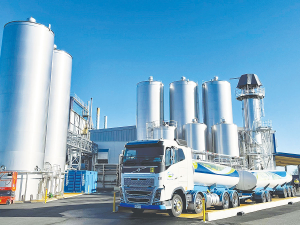Fonterra slashes forecast milk price, again
Fonterra has slashed another 50c off its milk price forecast as global milk flows shows no sign of easing.
 Fonterra will spend $700 million to improve its manufacturing operations and supply chain emissions footprint.
Fonterra will spend $700 million to improve its manufacturing operations and supply chain emissions footprint.
Fonterra is splashing out $700 million to improve its manufacturing operations and supply chain emissions footprint.
The cc-operative has come out with a new Scope 1&2 emissions reduction target which it says will be achieved by bringing forward some of its work to get out of coal. The Government will chip in $90m.
Fonterra chief executive Miles Hurrell says the co-op is targeting a 50% absolute reduction in Scope 1&2 emissions by 2030, from a 2018 baseline, an increase on its previous target of a 30% reduction by 2030.
“Fonterra’s Scope 1&2 emissions largely come from our manufacturing operations and supply chain. Strengthening our emissions reduction target supports our ambition to be net zero by 2050,” says Hurrell.
Achieving the new target will require Fonterra to continue to undertake energy efficiency improvements and fuel switching to renewable energy source activities across its milk collection fleet and manufacturing sites, with a focus on the six where it uses coal.
To do this, Fonterra is forecasting an investment of $790 million, including a government contribution of up to $90 million through the Government Investment in Decarbonising Industry (GIDI) fund.
Hurrell says as a co-op, Fonterra understands how it can achieve more by working together.
“The addition of Government funding enables us to lift our 2030 ambition to reduce Scope 1&2 emissions by 50% and optimise our process to get out of coal by 2037.
“Our decarbonisation plan will see us explore multiple technologies to ensure the most efficient phase out of coal and transition to renewable energy across our manufacturing sites, while building resilience into our operations.
“We are already well underway with shifting our manufacturing operations to renewable energy sources. Over the past five years, we have carried out decarbonisation projects at five different sites and we’re looking forward to continuing this momentum.
“We’re currently assessing biomass, electrification and heat pump technology at our Clandeboye and Edendale sites. We see these technologies as the best solutions possible at this stage.
“Accelerating our plans will help Fonterra continue to present our customers with the world’s lowest carbon dairy at scale. It will also contribute to New Zealand meeting its climate targets while delivering benefits across regional New Zealand, such as job opportunities in local communities,” says Hurrell.
The co-op is currently talking with farmers about a Scope 3 emissions target, which will be announced shortly.
Dairy prices have jumped in the overnight Global Dairy Trade (GDT) auction, breaking a five-month negative streak.
Alliance Group chief executive Willie Wiese is leaving the company after three years in the role.
A booklet produced in 2025 by the Rotoiti 15 trust, Department of Conservation and Scion – now part of the Bioeconomy Science Institute – aims to help people identify insect pests and diseases.
A Taranaki farmer and livestock agent who illegally swapped NAIT tags from cows infected with a bovine disease in an attempt to sell the cows has been fined $15,000.
Bill and Michelle Burgess had an eye-opening realisation when they produced the same with fewer cows.
It was love that first led Leah Prankerd to dairying. Decades later, it's her passion for the industry keeping her there, supporting, and inspiring farmers across the region.
President Donald Trump’s decision to impose tariffs on imports into the US is doing good things for global trade, according…
Seen a giant cheese roll rolling along Southland’s roads?